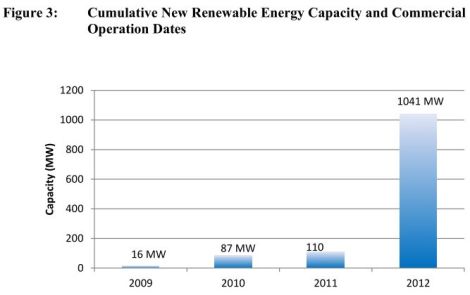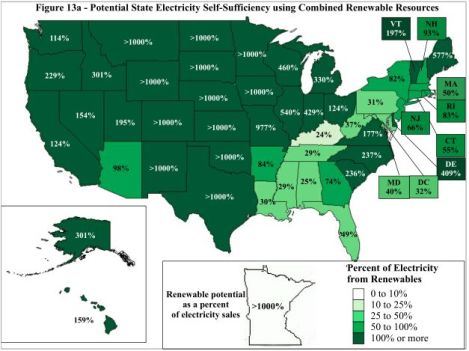
Michigan: Great Lakes, great expectations. (Image courtesy of Shutterstock.)
Probably the most important energy-related vote this November is happening in the swing state of Michigan, where voters will decide whether to substantially boost the state’s renewable energy standard (RES). It’s a big deal for all sorts of reasons, many of which extend beyond the state itself. So let’s walk through the background.
In 2008, Michigan passed a law to require the state’s utilities to generate 10 percent of their power from renewable energy sources by 2015. It was an extremely cautious RES, full of defensive provisos prohibiting anything that would cost more than coal power or raise electricity rates.
This year, the Michigan Public Service Commission, which oversees compliance, issued an updated report [PDF] on how implementation is going. The top-line conclusion is that implementation is going smoothly and “providers are on pace to hit the 2012 interim targets as well as the 10 percent by 2015 renewable energy standard.” Whee!
Renewable energy in the state is exploding:
Between 2008 and 2011, the RES attracted more than $100 million in new investment to the state. Michigan electricity prices are down, due to the recession and cheap natural gas, but the report notes that renewable energy doesn’t seem to have had any discernible effect at all on prices: “The electricity market has absorbed this initial level of capacity injections and demand reductions with little to no fluctuation in prices.”
In the last year, according to an appraisal [PDF] by the commission, the state’s electricity prices have started creeping back up, but that’s due to imported coal power, not renewables. Costs for renewables have been lower than expected, causing utilities to repeatedly lower their clean-energy surcharge. In fact, the combined average price of all Michigan’s new clean energy was lower than the price of electricity from conventional coal plants.
In 2010, there were almost 80,000 green jobs in Michigan. The report notes that new jobs generated by the RES haven’t yet been clearly quantified (an assessment is due later this year), but that “Michigan has the potential to become a regional leader in development and manufacturing of renewable energy systems.”
So: new jobs and investment without raising costs to consumers. It’s going pretty well!
Earlier this month, a coalition of local business and environmental groups called Michigan Energy, Michigan Jobs submitted 530,000 signatures (the state requires 322,000) to put a new proposal on the ballot that would expand the renewable energy standard. The new target would be 25 percent clean energy by 2025. The proposal is widely popular among small businesses and state energy experts.
This year, the Illinois Power Agency issued an assessment [PDF] of that state’s RES, which happens to be 25 percent by 2025. It found that “renewable resources, in particular wind, have played a dramatic role in reducing electric energy prices in Illinois and the entire Eastern Interconnection” and that the RES has “enabled significant job creation and economic development opportunities as well as environmental benefits.” Sounds pretty good.
Right now, energy bleeds money out of Michigan. Check out this grim diagnosis from the state’s Public Service Commission last year:
Michigan is relatively limited in most energy resources and imports 97 percent of its petroleum needs, 82 percent of its natural gas and 100 percent of coal and nuclear fuel from other states and nations. These imports account for about 72 cents of every dollar spent for energy by Michigan’s citizens and businesses. Michigan spent a total of $31.3 billion on all forms of energy in 2009 and of that amount $22.6 billion was for the energy resources imported from other states and nations.
The thing is, it doesn’t have to be this way. Michigan is not limited in its energy resources. In fact, Michigan has enough local renewable energy to power itself three times over:
Hell, according to the National Renewable Energy Laboratory, Michigan could power itself with onshore wind alone.
The more Michigan develops its local renewable resources, the more electricity generation becomes a boon, an economic growth engine, rather than merely a cost. Energy money stays in the state and circulates in local communities (Michigan already has a substantial wind and solar supply chain [PDF]) rather than being transferred to out-of-state fossil-fuel companies. Michigan wins: more economic activity, more jobs, more pollution-free energy, more pride.
None of that sounds good to the Michigan Chamber of Commerce and the state’s big utilities. They have united behind a front group called Clean Affordable Renewable Energy for Michigan (CARE) that is battling to defeat the proposal. CARE has raised more than twice the money of clean-energy proponents and begun bombarding Michigan voters with $5.2 million worth of advertising pushing bogus scare stories about the high costs of clean energy.
This is part of a broader war on state renewable energy standards being waged by ALEC and other conservative groups. They face an uphill battle: Voters in Michigan and other Midwestern states overwhelmingly support clean energy, as do voters across the country. Most importantly, independents side with Democrats on this. And some of the most important swing states are also the ones with the most renewable energy potential. The more cleantech establishes itself in these states, the more their governors will start acting like Chris Christie and the more clean energy will be freed from its partisan connotations.
The only way conservative fossil-fuel interests can win on that unfavorable terrain is with big money and big lies. That’s the contest in Michigan in November. Its outcome will reverberate in other states.





